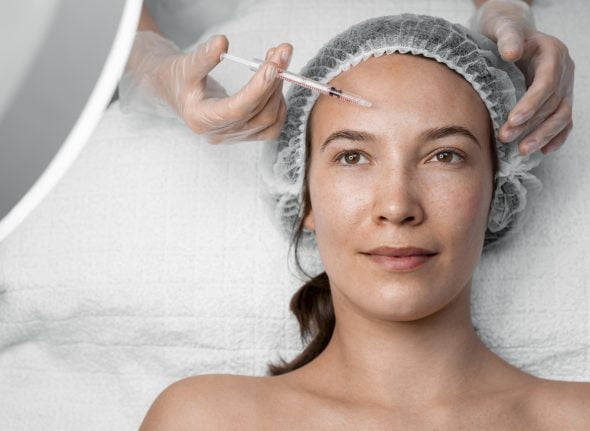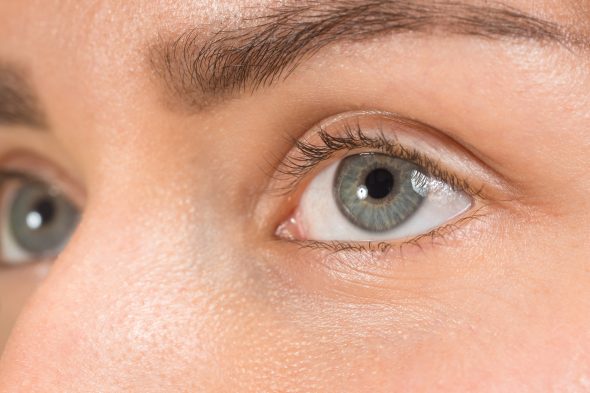

Early stage skin cancer on eyelid
Daniel Ezra, 13 February 2023

All you need to know
An eyelid tumour is an abnormal growth of new tissue on the upper or lower eyelid. These tumours can be benign, which means they don’t invade other tissues, or malignant, which means they can invade surrounding tissues and spread to other parts of the body. They can often easily be mistaken for an eyelid cyst or blepharitis. For this reason, it is important to be able to recognise early-stage skin cancer on the eyelid. In this blog post, we’ll look at how to differentiate an eyelid tumour from other forms of skin lesions, and the importance of it.
What is eyelid cancer?
Eyelid cancer is the abnormal growth of skin cells on the eyelid. The main types of skin cancer are basal cell carcinoma, squamous cell carcinoma, sebaceous cell and melanoma. Skin cancer often develops on areas exposed to the sun, such as the face. Around 5% to 10% of all skin cancers occur in the eyelid.
Basal cell carcinoma
Basal cell carcinoma is the most common type of eyelid cancer and forms in the basal cells, which are one of three types of cells that make up the top layer of skin. Basal cell carcinomas make up around 85% to 95% of eyelid cancers. It usually appears in the lower lid and is more likely to occur in people with fair or pale skin.
It can take the form of a waxy bump, a white or pink patch, an open sore, an elevated growth with rolled edges, or a growth that crusts, itches, oozes or bleeds.
Basal cell carcinomas are usually slow growing but can invade local tissues. It is important to catch these early so that they can be removed in entirety. If these are allowed to grow large, following excision, patients may be left with a large defect which is more difficult to reconstruct.
Squamous cell carcinoma
Squamous cell skin cancer makes up around 5% of all eyelid cancer.
Squamous cell carcinoma is a type of cancer that forms in the flat squamous cells near the surface of the skin. It is different from basal cell carcinoma, which usually forms on sun-exposed areas of the skin, because it can also develop around the genitals and other areas of the body that are not exposed to sunlight. A possible squamous cell carcinoma could manifest as a scaly red patch, a tough and thickened patch of skin, a wart, or a raised growth with a depression.
Squamous cell carcinoma is common but usually very treatable. If you notice any abnormality on your skin, it is important to promptly seek care, as if treatment is delayed, early eyelid skin cancer like this can spread to other parts of the body.
Sebaceous carcinoma
Sebaceous carcinoma is a type of cancer that most commonly affects middle-aged to older adults. It can start in the meibomian glands, which are glands that secrete a fatty substance that lubricates the eyelids, or in the Zeis glands, which are sebaceous glands located at the base of the eyelashes.
This type of early stage skin cancer on the eyelid is most often found on the upper eyelid. It has been linked to exposure to radiation, Bowen’s disease, and Muir-Torre syndrome.
Sebaceous gland carcinoma often appears as a firm, painless lump which will often be a red colour. This type of eyelid skin cancer is often misdiagnosed as blepharitis. Therefore, it is important that you are promptly assessed if you have blepharitis not resolving to treatment or affecting just one eye.
It is important to always treat early eyelid skin cancer quickly to prevent local invasion and spread to the rest of the body.
Melanoma eyelid cancer
Melanoma, which makes up less than 1% of all eyelid cancer, is a cancer that begins in the melanocytes.
Melanocytes are the pigment-producing cells located on the top layer of the skin. Ultraviolet (UV) light from the sun and tanning beds can trigger cancerous changes in these cells, but melanoma may also develop in areas of the body that aren’t exposed to the sun.
Warning signs of melanoma early eyelid skin cancer may include a mole that is a different shape, size, or colour from other moles on your body; has multiple shades of tan, brown, or black; has an irregular border; or gradually changes colour or shape. Although melanomas are typically pigmented, unpigmented forms of melanoma also exist.
If you notice any changes in the appearance of a mole, it is important to be referred to an ophthalmologist to rule out skin cancer.
Melanoma skin cancer can be very serious. It is therefore important to monitor any suspicious moles on the eyelid and to receive early treatment.
When to see an ophthalmologist
If you notice any new lesions on the eyelids which are not resolving or if you notice that a mole has changed in appearance, it is important to be reviewed by an ophthalmologist.
Other than the specific symptoms outlined above, some changes to be aware of include the swelling or thickening of the eyelid, chronic infection of the eyelid, ulceration (an area where skin is broken) on the eyelid that does not heal, a change in the position or direction of the eyelid, a change in the size, shape, or colour of the pupil, and the appearance of a lump on the eyelid.
While these could all be symptoms of something else, it is important to stay aware of potential signs of cancer of the eyelid and to contact your ophthalmologist quickly to ensure early detection.
You may be referred for a biopsy in order to diagnose any issues. Other tests may be suggested, such as imaging tests, to find out whether a cancer has spread. Your treatment options will depend on your diagnosis, but they may involve removal of the affected area, radiation therapy or chemotherapy.
If you detect a change in the skin on or around your eyelid or in existing lesions in the area, it is always a good idea to contact an ophthalmologist. Schedule a consultation with us to talk through the changes in your skin and take any necessary action in good time to treat early eyelid skin cancer.

